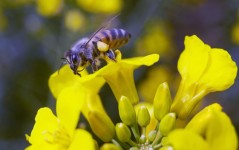Multiple Factors Affect Bee Health – EPA, USDA Report

The U.S. Department of Agriculture (USDA) and U.S. Environmental Protection Agency (EPA) released a comprehensive “Report on the National Stakeholders Conference on Honey Bee Health” on May 2, finding a complex web of factors that affect honey bee populations.
The report summarizes findings from the National Stakeholders Conference held in October 2012, which brought together beekeepers, scientists, representatives of conservation groups, beekeeping supply manufacturers, commodity groups, pesticide manufacturers and government representatives to discuss potential solutions for improving honey bee health.
“The decline in honey bee health is a complex problem caused by a combination of stressors, and at EPA we are committed to continuing our work with USDA, researchers, beekeepers, growers and the public to address this challenge,” said acting EPA Administrator Bob Perciasepe. “The report … is a the product of unprecedented collaboration, and our work in concert must continue. As the report makes clear, we’ve made significant progress, but there is still much work to be done to protect the honey bee
population.
Key findings of the report include:
- The parasitic Varroa mite is recognized as the major factor underlying colony loss in the U.S. and other countries;
- Nutrition has a major impact on individual bee and colony health, and nutrition problems can make bees more susceptible to harm from diseases and parasites;
- There is a need for informed and coordinated communication between growers and beekeepers as well as effective collaboration between stakeholders on practices to protect bees from pesticides;
- U.S. honey bee colonies need increased genetic diversity in order to improve thermoregulation, disease resistance and worker productivity;
- Additional research is needed on realistic field-relevant pesticide exposure to bees.
In a statement, CropLife America urged USDA and EPA to “promptly translate the results of the conference and this report into concrete, practical research directions.”
“This report offers additional confirmation that there are numerous factors influencing the health of honey bees,” said Dr. Ray McAllister, senior director of regulatory policy for CLA. “CLA supports the work of USDA, EPA and all involved stakeholders who are collaborating on developing solutions for honey bees and other pollinators, which are so vital to agricultural production in the U.S. and worldwide. The crop protection industry is dedicated to analyzing the impacts of pesticides on honey bee colonies through continued research into field-relevant pesticide exposures, improvement of pollinator habitats, supporting educational outreach programs and applying best management practices.”





